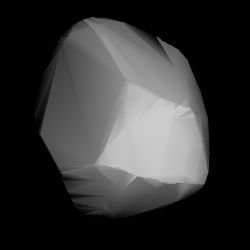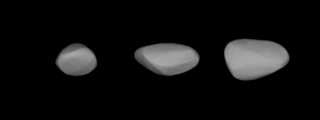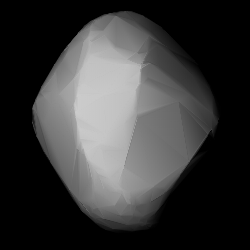
147 Protogenia is a large main belt asteroid that was discovered by Hungarian astronomer Lipót Schulhof on July 10, 1875, from the Vienna Observatory; it was his only asteroid discovery. Its name is Greek for "first born" and was chosen by Karl L. Littrow in allusion to the fact that this was the first asteroid discovered by an astronomer who was already known for work in other fields of astronomy.

188 Menippe is a main belt asteroid. The object has a bright surface and rocky composition. It was discovered by C. H. F. Peters on June 18, 1878, in Clinton, New York, and named after Menippe, one of the daughters of Orion in Greek mythology.

217 Eudora is a large Main belt asteroid. It was discovered by French (Corsican) astronomer J. Coggia on August 30, 1880, in Marseilles, France. It was his fourth asteroid discovery and is named after Eudora, a Hyad in Greek mythology.

273 Atropos is a typical Main belt asteroid that was discovered by Austrian astronomer Johann Palisa on 8 March 1888 in Vienna.

365 Corduba is a very large main-belt asteroid that was discovered by the French astronomer Auguste Charlois on 21 March 1893 from Nice. It is classified as a C-type asteroid and is probably composed of carbonaceous material.

400 Ducrosa is a typical Main belt asteroid. It was discovered by Auguste Charlois on 15 March 1895 in Nice.
536 Merapi is a main belt asteroid orbiting the Sun. It was discovered by American astronomer George Henry Peters on May 11, 1904, from Washington, D.C.
568 Cheruskia is a minor planet, specifically an asteroid orbiting in the asteroid belt that was discovered by German astronomer Paul Götz on 26 July 1905 from Heidelberg.
585 Bilkis is a minor planet, specifically an asteroid orbiting in the asteroid belt. It was discovered by German astronomer August Kopff in 1906 February and was given the Koran name for the Queen of Sheba. Photometric observations at the Palmer Divide Observatory in Colorado Springs, Colorado in 2006–7 were used to build a light curve for this object. The asteroid displayed a rotation period of 8.5742 ± 0.0005 hours and a brightness variation of 0.40 ± 0.02 in magnitude.

605 Juvisia is a minor planet, specifically an asteroid orbiting in the asteroid belt that was discovered 27 August 1906 in Heidelberg by German astronomer Max Wolf. It was named after the commune Juvisy-sur-Orge, France, where French astronomer Camille Flammarion had his observatory.
611 Valeria is a minor planet orbiting the Sun that was discovered by American astronomer Joel Hastings Metcalf on September 24, 1906, from Taunton, Massachusetts. The name may have been inspired by the asteroid's provisional designation 1906 VL.
618 Elfriede is a minor planet orbiting the Sun. On July 24, 2013, it occulted the magnitude 12.8 star 2UCAC 23949304, over parts of Mexico and southwestern United States.
620 Drakonia is a minor planet, specifically an asteroid orbiting in the asteroid belt. It was discovered October 26, 1906, in Taunton, Massachusetts, by American astronomer Joel Hastings Metcalf and given the preliminary designation 1906 WE. It may have been named for Drake University.
687 Tinette is a minor planet, specifically an asteroid orbiting primarily in the asteroid belt. It was discovered by Austrian astronomer Johann Palisa on 16 August 1909 from Vienna and was given the preliminary designation 1909 HG.
730 Athanasia is a background asteroid from the inner regions of the asteroid belt, approximately 4.5 kilometers in diameter. It was discovered by Austrian astronomer Johann Palisa at the Vienna Observatory on 10 April 1912. The presumed stony S-type asteroid has a rotation period of 5.7 hours and is likely very elongated in shape. It was named Athanasia, the Greek word for "immortality".

747 Winchester is an asteroid, a minor planet orbiting the Sun. It was discovered in 1913, and is named after the town in which it was discovered, Winchester, Massachusetts, in the USA.
758 Mancunia is a minor planet orbiting the Sun. It was discovered in 1912 from Johannesburg by H. E. Wood, a Mancunian. This object is orbiting at a distance of 3.19 AU with a period of 5.70 years and an eccentricity (ovalness) of 0.15. The orbital plane is inclined at an angle of 5.61° to the plane of the ecliptic.

787 Moskva is a minor planet orbiting the Sun. It is a dynamic member of the Maria asteroid family orbiting near the 3:1 Kirkwood gap. This is an S-type (stony) asteroid spanning 27 km. The surface mineralogy is consistent with mesosiderite silicates.
829 Academia is a minor planet orbiting the Sun. The asteroid is roughly 44 km in diameter and has a low albedo. Photometric measurements of the asteroid made in 2005 at the Palmer Divide Observatory showed a light curve with a period of 7.891 ± 0.005 hours and a brightness variation of 0.44 ± 0.02 in magnitude.
5682 Beresford, provisional designation 1990 TB is a stony asteroid and sizable Mars-crosser from the inner regions of the asteroid belt, approximately 6 kilometers in diameter. It was discovered on 9 October 1990, by astronomer Robert McNaught at the Siding Spring Observatory in Australia. The assumed S-type asteroid has a short rotation period of 3.8 hours. It was named after Australian amateur astronomer Anthony Beresford.









